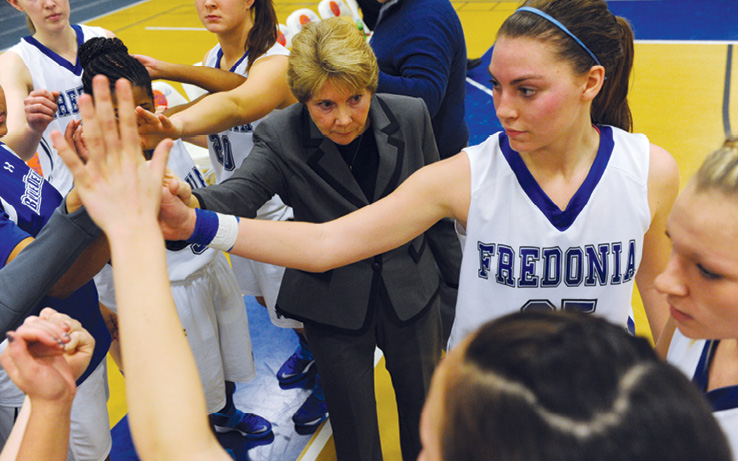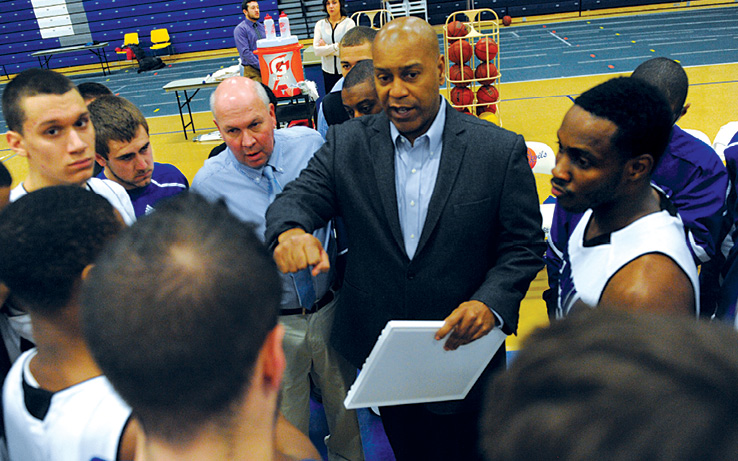
Linda MacDonald, a former head coach in the WNBA and three different Division 1 programs, prepares the Blue Devils to take the floor in December.
by Jerry Reilly, director of Sports Information
She had been on the job for just over one week and Linda Hill MacDonald was already appreciating some of the differences between big-time women’s college basketball and NCAA Division III.
One afternoon, for instance, she was reminiscing about her impressive career — it includes head coaching jobs at three NCAA Division I schools, plus the WNBA — when two of her new players ducked their heads through her Dods Hall office door.
“Hello ladies, are you coming back from the gym?,” MacDonald asked the pair, who indeed had just spent the better part of the last hour shooting jump shots — and retrieving the ball for each other — inside the mostly empty Steele Hall Fieldhouse.
“A lot of the players have been stopping by,” the veteran coach said after the pair had left to grab a late lunch before practice. “I find that so refreshing. I used to get that when I coached in high school. When I started in college, it changed. The freshmen would stop by at the start of each semester because they were homesick, I think. But eventually even they stopped coming by.”
Raised in Morton, Pa., MacDonald was a two-sport standout — basketball and lacrosse — at West Chester University. Following college graduation, she first became a middle school coach and later a head coach at her high school alma mater in the Ridley (Pa.) school district.
She broke into the college ranks in 1980 at Temple University, where she became the first woman to serve as the Owls’ full-time head coach. She led the Owls to their first post-
season appearance — a trip to the WNIT — and later, to the NCAA Tournament. She was twice named Atlantic 10 Coach of the Year.
Her next stop was the University of Minnesota, where the Gophers also claimed an NCAA bid. While there, MacDonald became president of the national Women’s Basketball Coaches Association. She also took up the fight for gender equity and lobbied the Minnesota state legislature to make the pay for the coaches of women’s teams more in line with what they were paying coaches of men’s teams.
Her lobbying would pay off down the line for her — and others.

Former New York Knicks draft choice Phil Seymore works up a play for his Blue Devils on the sideline last fall.
Like MacDonald, new men’s basketball coach Phil Seymore, who also has an extensive big-college coaching background, is finding that coaching at Fredonia State is as much about having a personal connection with their student-athletes as it is about teaching Xs and Os.
“I like practice (the most),” Seymore said when asked about his favorite part of coaching, “but I also like developing relationships with the players, managers and people involved with the program. It always feels good when you can have someone call you five to 10 years down the road and talk about the things they learned when they played for you. That’s a great feeling to know that you had an impact.”
A native of Brooklyn, Seymore attended junior college in the Midwest before returning east and transferring to Canisius College. He was a two-year standout for the Golden Griffs, good enough to be chosen by the New York Knicks in the 1982 NBA Draft. Cut by the Knicks during training camp, he caught on with the Albany Patroons of the then-Continental Basketball Association.
Albany was generally regarded as one of the top CBA franchises. The team was coached by former NBA player — and soon to be Chicago Bulls’ head coach — Phil Jackson, and Seymore was one of the Patroons’ top players. Yet after just one season, he’d left the team and never looked back.
“I had proven to myself,” he said, “that I could play professionally. It was time to get on with the rest of my life.”
His dream at the time was to teach middle school and coach basketball, even if it meant volunteering as a coach. Instead, fate intervened. Al Monaco, the first-year head coach at Turner-Carroll High School in Buffalo, left to go to Williamsville South. He positioned Seymore for the head coaching job. After two years as the head varsity coach, he entered the college ranks as a paid assistant at his alma mater. When Canisius head coach John Beilein left for Richmond, Seymore left with him — yet did not follow Beilein to West
Virginia (or Michigan). Instead, Seymore moved on to Providence College.
After five years as men’s assistant coach, Seymore heard Providence was looking for a head coach of its women’s basketball program. Although he had never coached women, Seymore asked about the opening. He was hired after a long interview process. The new job carried a nice pay raise. The gender equity MacDonald had fought for in Minnesota had paid another dividend.
MacDonald had just completed her seventh season at Minnesota when she was given the opportunity of a lifetime.
The National Basketball Association Board of Governors announced its intent to form a women’s professional league beginning in 1997. Cleveland was granted one of the original eight franchises and chose her as its first head coach.
She spent three seasons as coach of the Rockers, the name chosen for the Cleveland team, and still talks with pride of being in on the ground floor. The WNBA will play its 18th season next summer.
“I was employed,” she said, “by a very good franchise. Wayne Embry was the general manager and he had been in the business on the men’s side forever, so things went pretty smoothly. He and the team president, Gordon Gund, wanted things done exactly for the women as they were for the men.”
That meant separate offices and a large marketing budget and a separate wooden floor for home games. Rocker players were encouraged to make appearances in the Cleveland community, and average attendance was over 10,000 during the inaugural season.
MacDonald left the Rockers after the 1999 season, yet stayed in the league as an assistant coach and scout. “My takeaway,” she said of her WNBA days, “was personal growth. The coaching part was the same, but the people management was very different. There was definitely a learning curve for me. You had some prima donnas, and some hard workers, and others who approached it as nothing more than a job, whereas in college you’re accustomed to guiding your women into their adulthood.”
It wasn’t long before she was back in the college game.
Coach Seymore’s first few weeks at Fredonia State were a whirlwind. He met with all the returning players, and the parade of walk-ons. He appointed two student assistants and interviewed candidates for assistant coach. He also extended an offer to his old boss, Al Monaco, to come work on his staff. Monaco accepted.
After the groundwork was laid, Seymore took a two-week long recruiting trip to eastern part of the state, visiting all five boroughs, Long Island, Westchester County and New Jersey. “I think it was huge for me to get out there,” he said, “and go to two or three schools in one day, then get up the next day and get to another two or three schools. I think it paid some dividends.”
John Fischetti, an All-SUNYAC guard who’s in the Fredonia State Hall of Fame, helped Seymore make several contacts during the Long Island trip. Another Hall of Famer, Chris Hughey, living outside Washington, D.C., has been in touch. So, too, has Pat Swick, also a former Blue Devil guard, living in Western Pennsylvania. Yet the majority of Seymore’s recruits will still need to come from in-state.
Sometimes friends are all too eager to help. Recently, one of them called Seymore to say he had a player who might be of interest.
“Phil, I’ve got this guy for you,” the friend said. “He’s 25-years-old but he’s really good. This kid can play.”
Seymore’s friend then put the prospect on the phone. “What have you been doing since high school?” Seymore asked. “Junior college? The army?”
“I was just working,” the player replied. “But I got my G.E.D.”
Seymore had to gently let down the player — and his friend. “That’s not going to work at Fredonia,” he said as he recounted the story a couple of weeks later. “But people have to learn the criteria here. People need to be educated, so the more we go out recruiting, the more we can say ‘This is the type of program we’re building at Fredonia.’ It’s all about putting our name out there. The more you put our name out there, the more people will be intrigued.”
With her WNBA coaching and scouting experiences now behind her, MacDonald settled back into the coaching ranks. She had two separate stints as an assistant coach at the University of South Carolina before moving to Western New York to become head women’s basketball coach at the University at Buffalo.
If Seymore’s early weeks at Fredonia State were a whirlwind, MacDonald’s first few days were a blur. She met her future team one afternoon during a quick visit to campus, and ran her first practice the next time they were together. Like Seymore, she has only part-time help — actually less of it. Alumnus Rich Norton, an area public school teacher, is in his second year with the program. He ran practices for the first week before MacDonald’s appointment was official. The plan is for Norton to oversee the recruiting — make initial contacts before MacDonald follows up. “That’s just getting started,” she said of getting on the recruiting trail. “I’m caught up with the season right now…I’ve really been busy and I don’t have anyone with me here during the day to help get me through the busyness.”
Connecting with alums has also taken a back seat, for now. The annual alumnae game was held in mid-October, during Homecoming Weekend, so any chance she might have had to meet former women’s players had come and gone by the time she arrived on campus. Instead, she intends on writing an introductory letter to former players — when she’s finished preparing practice plans and writing scouting reports.
“We need to preserve the history of this program,” she said. “That’s an important part of keeping the alumnae connected…and not letting the players who are currently here forget they are here because of those who came before them.”
MacDonald inherited a Blue Devil team led by two accomplished seniors. Becky Hebert (Hilton) has led the SUNYAC in scoring each of the last two seasons, and could become Fredonia State’s all-time leading scorer later this season. Jaimie Warren (Lake View) has worked herself up onto Fredonia State career Top 10 lists for points and rebounds.
That has eased her transition considerably. The Blue Devils had a 6-2 record at the end of the first semester. She’s reluctant to take any of the credit.
“I don’t have anything unique to bring,” MacDonald said, understating her nearly 40 seasons teaching women’s basketball — 25 of them as a college head coach. “I probably have a little bit different approach, and whether that’s good or bad remains to be seen. (But) what I do bring is a vast knowledge of the game. And I can share the experiences I’ve had, of some of the players I’ve coached.”
Her players have been all ears.



